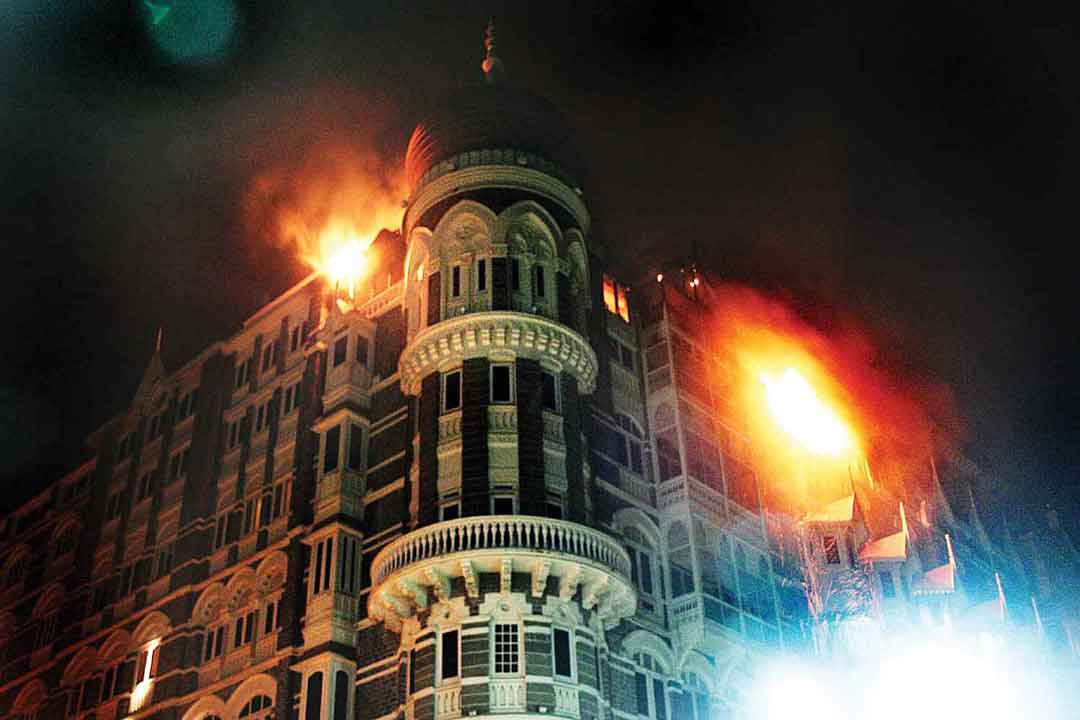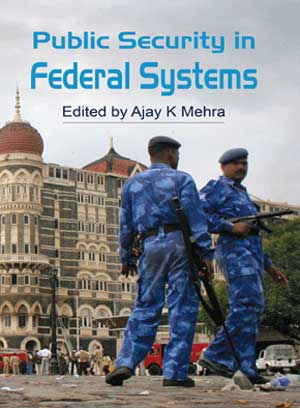
The heritage wing of the Taj Mahal Palace and Tower aflame, November 26. (Photograph: Uttam Ghosh/rediff.com)
The audacious and diabolic attack by the sea-borne terrorists on the iconic targets of Mumbai on 26 November 2008 stunned the nation like it had never been before. The sixty-hour-long tragic mayhem was witnessed across the world. It was a frontal attack by the terrorist outfit Lashkar-e-Toiba (LeT) which openly declares its avowed objective to disintegrate India. The attack resulted in the tragic deaths of 166 people from India, the USA, the UK, Israel, France, Germany, Italy, Canada, Thailand, Singapore, Australia, Mauritius and Belgium besides injuries to 304 others.
…the question that begs answers it why was this attack not prevented or tackled professionally, in spite of repeated intelligence alerts about the possible LeT attack on Mumbai.
In the past two decades, India has faced a series of terrorist attacks – the first major one being the serial Mumbai blasts in 1993 which left 193 dead and hundreds injured. The other sensational terrorist incidents were the hijacking of an Air India flight from Kathmandu to Kandahar in December 1999, LeT attack on the Red Fort in 2000, attack on the State Assembly in Srinagar in 2001, attack on the Parliament in December 2001, attack on Akshardham temple (Ahmedabad) in September 2002, Samjhauta Express (the train between India and Pakistan through Punjab) explosion (66 casualties) in February 2007 and scores of blasts in metropolitan cities across India including Ahmedabad, Bangalore, Jaipur, Hyderabad, Pune, Delhi and Mumbai leaving hundreds dead, maimed and injured.
The 26/11 Mumbai attack received an unprecedented worldwide attention in spite of the metropolis being a victim of terror in the past as well. In 2006 for instance, multiple blasts in suburban trains had killed more than 200 commuters in the city. However, the 26/11 attack was audacious and such an attack had never been witnessed earlier – not to mention on live TV. It resulted in the deaths of several foreign nationals as well, drawing attention internationally. Additionally, LeT’s growing nexus with Al-Qaida and their plan to target the West alarmed the U.S.
26/11 also jolted India’s political establishment in its aftermath. The Chief Minister of Maharashtra and the Union Home Minister had to quit. Several measures were taken to revamp the security systems both at the state and central levels. However, the question that begs answers it why was this attack not prevented or tackled professionally, in spite of repeated intelligence alerts about the possible LeT attack on Mumbai. Although no comprehensive enquiry on the line of 9/11 was ordered by the Union Government, the High Level Enquiry Committee (HLEC) appointed by the Maharashtra Government has come out with a report which throws light on the security system and its response to the 26/11 attack.
The initial denial by the Additional Chief Secretary (Home) about the intelligence alerts and later blaming the ‘Desk Officer System’ is bizarre…
Intelligence Fiasco
The most shocking revelation of the HLEC is on the manner in which the higher authorities handled the numerous intelligence alerts about the possible attack on Mumbai. The HLEC has passed scathing comments on the system which was supposed to have acted upon the intelligence alerts and to have prepared and averted the impending terrorist attack. The HLEC observed:
“All intelligence alerts are mechanically forwarded to operation units either by DGP’s office or Anti Terrorist Squad (ATS) or by the home department. There was total confusion in the processing of intelligence alerts at the level of the State Government.” (The High Level Enquiry Committee (HLEC) Report: Section 1, Para 16.1)
“Both Additional Chief Secretary (Home) and Principal Secretary (Home) initially gave in writing to the committee that they had not received any intelligence alert form MHA (Ministry of Home Affairs). However, the DGP had furnished copies of several important intelligence alerts issued by MHA addressed to the Chief Secretary, Home Secretary and so on.” (The HLEC Report: Section 2, Para 3.90)
“Under the ‘Desk Officers System’ even intelligence alerts received from MHA were directly received and processed by the concerned desk officer instead of the Additional Chief Secretary (Home) directly receiving and handling these sensitive communications. For the committee this is a shocking revelation.” (The HLEC Report: Section 1, Para 18)
The initial denial by the Additional Chief Secretary (Home) about the intelligence alerts and later blaming the ‘Desk Officer System’ is bizarre and speaks volumes about the cavalier attitude and functioning of the bureaucracy entrusted with the safety and security of the people and the nation at large.
The Mumbai Police does have the ATS and Quick Reaction Teams (QRTs), but there was no one to lead them…
The First Responder: Mumbai Police
The Mumbai Police- the first responder was found utterly wanting in facing the terror attack on 26/11. Barring the heroic action of a few police officers, the Mumbai Police, according to the HLEC, responded in a manner as if it were a routine law and order situation. Policemen who rushed to the locations of terrorist attacks had only lathis (wooden clubs). Even the police mobile vans which followed had lathis, gas guns and archaic .303 (of the Second World War vintage with some improvements) rifles to face the terrorists who were equipped with AK-47 assault rifles, hand grenades and lethal explosives. The Mumbai Police does have the ATS and Quick Reaction Teams (QRTs), but there was no one to lead them. The glaring omissions and commissions on the part of the Police Commissioner (CP) himself such as ignoring Standard Operating Procedures (SOPs) marked the response of the police under his command. The HLEC severely indicted the Police Commissioner and the system under his command:
“The CP should have been in the command centre in the control room which might have helped in better utilization of forces and prevented duplication of efforts by different police units.” (The HLEC Report: Section 2, Para 3.70.1)
“If each top officer, such as the CP or the DGP treats SOPs in a cavalier manner, why have the SOPs at all?” (The HLEC Report: Section 2, Para 3.70.2)
“Mumbai City policemen were not regularly given firing practice.” (The HLEC Report: Section 2, Para 3.48)
“The Quick Reaction Teams (QRTs) were not used for the purpose they were created for and were split into small groups/units.” (The HLEC Report: Section 2, Para 3.58)
“The QRT was not effective in making an assault in Taj and Oberoi since they were split in small units.” (The HLEC Report: Section 2, Para 3.59)
“None in Colaba Police Station or for that matter SB II (Special Branch) knew about the existence of a Jewish settlement in Nariman House. Had the operational units been sensitized about the known prejudices of such terrorist groups against Jewish groups, perhaps the threat could have been better handled.” (The HLEC Report: Section 2, Para 3.74)
Such glaring deficiencies in a system can thus make the state highly vulnerable to terrorist attacks.






Agree with the author’s assertion that prior warnings were sufficient to provoke emergency measures. The facts are that the state and federal leaders were fast asleep at the steering wheel while the Mumbai car crashed. In that incident alone, over 150 ordinary citizens without the privileges of six-gun-totting-Sakaram’s protection, became the victim of cold bloody murderers from Pakistan. This was not the first or the second such development but many in a series of Jihadis crossing border and duck-shooting Indians, exploding bombs in public places and causing parliament insurrections. The blame lies squarely on the shoulders of the Federal and State leaders. Why is it that in the United States after 9/11 almost all Islamic suicide bombers, anarchists and terrorists were apprehended long before they could say allah-uh-Akbar before pulling the trigger. The key to this success is the state of preparedness. It includes nationalizing the security apparatus, appointing a Federal Czar preferably a military character, but definitely not a politician, and setting up a network of federally controlled rapid response organizations through states. The command and control normally supersedes all other agencies in order to respond within minutes, not hours or days. The fact that such a development has not already occurred in India shows the utter failure of the government and may be too late to prevent Mumbai 2.